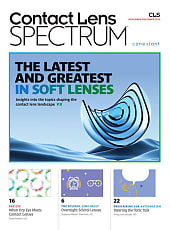By virtue of being the primary eye care provider, optometrists are often the first to diagnose diabetic retinopathy (DR). As a result, patients both rely on and expect us to provide education on DR and the treatments available to them.
What’s more, in doing so, patients are well-prepared to be part of the treatment conversation when seeing a retinal specialist. They appreciate this greatly, which creates patient loyalty to us and a better treatment experience for them.
Here, I provide the patient scripts I’ve used to educate DR patients on the currently available in-office ophthalmic treatments for the condition: Intravitreal injections, laser photocoagulation, and a combination of the two.

Intravitreal Injections
I’ve noted swelling at the center part of your retina. This part of your eye, called the macula, is responsible for your central vision. Eye injections may be necessary to reduce this swelling and preserve your vision. These injections, referred to as anti-VEGF, block a protein that causes the abnormal growth of blood vessels and their leakage, which can threaten your vision. These injections are typically given in a series, spaced several weeks apart, depending on the retinal specialist’s recommendations. On average patients get 6 to 8 injections the first year of treatment, with a significant decline in injections after. 1
The current injections available are brolucizumab (Beovu, Novartis) bevacizumab (off-label), aflibercept-8mg (Eylea HD, Regeneron), faricimab-svoa 6mg (Vabysmo, Genentech), and ranibizumab (Lucentis, Genentech; Susvimo, Roche). Additionally, your retina specialist may discuss with you the use of biosimilar injections, or those, close in makeup to the aforementioned injections.
In about 20% of patients, especially those who have a central retinal thickness (CRT) of 300 um or a reduction of CRT less than 10% after at least 3 to 6 injections, these injections are unsuccessful, or do not make enough of an impact. In such cases, switching to a different anti-VEGF injection or to an injection of corticosteroids, which help decrease swelling may be warranted. 2 The retinal specialist may wait 3 to 6 months before deciding to switch treatments.
Should you undergo injections, you may still be seen by the retinal specialist between treatments to ensure your diabetic retinopathy has not progressed.
Before the injection, a topical anesthetic will numb your eye, and a topical antiseptic solution will sterilize the injection area to minimize the risk of infection. The chance of infection from an intravitreal injection is <0.1%.3 Although the idea of an eye injection seems intimidating, the needle is very small, the procedure is very quick (often lasting less than a second), and the injection is administered away from the line of sight, so you won’t see it.
Common side effects after an injection include mild pain, floaters, redness in the white part of your eye, and light sensitivity.4 These symptoms are non-progressive and typically resolve on their own within a few days to a week. As with any procedure, there is always a chance for complications. A majority of signs and symptoms of infection appear after the 2-day mark, with those that manifest prior often non-infectious and benign.5 In cases of increasing visual decline, ocular pain, redness, flashes, or any loss of vision, you should call and return to the clinic immediately.6

Laser Photocoagulation
Focal or grid photocoagulation: I’ve identified a small red dot with surrounding leakage within your macula, the area that supplies your central vision. This leak can threaten your vision if left untreated. A method of focal laser targeting a single focal point can help seal the area of leaking. If the leakage is more widespread and a point of leak is difficult to discern, a grid pattern laser can be applied to help stop the leaking of fluid. This helps prevent further swelling in the center part of your retina and aids in reducing existing swelling.
Panretinal photocoagulation: In advanced stages of diabetic retinopathy, abnormal blood vessels can develop in the back of the eye due to areas of the retina that are deprived of oxygen. These vessels are prone to leakage, which can lead to vision-threatening complications. A procedure called panretinal photocoagulation employs a laser to create small burns within the retina that is deprived of oxygen and causing the proliferation of the abnormal blood vessels. Panretinal photocoagulation, which can be performed multiple times, is shown to reduce the risk of severe vision loss by 50%.7
The laser procedure typically follows these steps: An anesthetic drop is applied to numb the eye. A special contact lens may be placed on the eye to help focus the laser precisely. During the procedure, you may experience flashing lights and slight pain. Some side effects of the procedure include non-progressive mild eye ache, blurry vision, decreased peripheral vision, and a reduced ability to discern an object from its background. Most side effects should resolve within a few days to a week, but symptoms of decreased peripheral and night vision, along with the ability to discern objects can persist. The lasting symptoms are due to inevitable collateral damage to important retinal cells that contribute to our visual function.
Combined
In certain scenarios, laser and injections can be combined. The injection is given first to reduce the swelling at the center part of the retina, making the laser more effective. Within 1 to 6 months after the injection, the laser is employed.8-9 After the laser, injections are given on an as-needed basis. In another example, when both abnormal blood vessels and swelling in the macula are simultaneously present, intraocular injection and panretinal photocoagulation can effectively address both complications.
Should complications from diabetic retinopathy arise, out-patient surgeries, such as a vitrectomy, may be necessary. Your retina specialist will educate you on this surgery, should it become necessary.
Making an Informed Decision
Educating patients about the purpose of these treatments and what they can expect both during and after treatment allows them time to reflect, research, and ultimately make an informed decision about their ocular health. It’s no secret, that much of verbal communication can be forgotten by patients, so I recommend providing patients with supporting documentation of these scripts and, possibly using imaging of their DR to make a lasting impression. Finally, in recognizing time is at a premium for optometrists, I suggest considering having an allied staff member present when providing this education, so they can repeat it to patients and answer any questions.
References
1. Elman MJ, Ayala A, Bressler NM, et al. Intravitreal Ranibizumab for diabetic macular edema with prompt versus deferred laser treatment: 5-year randomized trial results.Ophthalmology. 2015;122(2):375-381. doi:10.1016/j.ophtha.2014.08.047
2. Madjedi K, Pereira A, Ballios BG, Arjmand P, Kertes PJ, Brent M, Yan P. Switching between anti-VEGF agents in the management of refractory diabetic macular edema: A systematic review. Surv Ophthalmol. 2022 Sep-Oct;67(5):1364-1372.
3. Mun Y, You SC, Lee DY, et al. Real-world incidence of endophthalmitis after intravitreal anti-VEGF injections in Korea: findings from the Common Data Model in ophthalmology.Epidemiol Health. 2021;43:e2021097. doi:10.4178/epih.e2021097
4. Milton Keynes University Hospital NHS Foundation Trust. Intravitreal injection. Accessed December 02, 2024. https://www.mkuh.nhs.uk/patient-information-leaflet/intravitreal-injection-2
5. Mezad-Koursh D., Goldstein M., Heilwail G., et al. Clinical characteristics of endophthalmitis after an injection of intravitreal antivascular endothelial growth factor. Retina. 2010;30:1051–1057. doi: 10.1097/IAE.0b013e3181cd47ed.
6. Retinal Physician. Panretinal Photocoagulation: Practical Guidelines and Considerations. Accessed March 25, 2025. http://retinalphysician.com/issues/2010/may-2010/panretinal-photocoagulation-practical-guidelines
7. Panretinal photocoagulation: practical guidelines and considerations. Retinal Physician. [ Dec; 2023 ]. 2023. http://retinalphysician.com/issues/2010/may-2010/panretinal-photocoagulation-practical-guidelines
8. Inagaki K, Hamada M, Ohkoshi K. Minimally invasive laser treatment combined with intravitreal injection of anti-vascular endothelial growth factor for diabetic macular oedema.Sci Rep. 2019;9(1):7585. Published 2019 May 20. doi:10.1038/s41598-019-44130-5
9. Nozaki M, Ando R, Kimura T, Kato F, Yasukawa T. The Role of Laser Photocoagulation in Treating Diabetic Macular Edema in the Era of Intravitreal Drug Administration: A Descriptive Review.Medicina (Kaunas). 2023;59(7):1319. Published 2023 Jul 17. doi:10.3390/medicina59071319.




